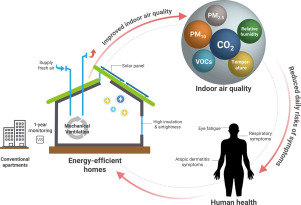Introduction
Indoor air quality is a crucial factor that directly impacts our overall health and well-being. Many people are unaware of the potential risks associated with poor indoor air quality, which can lead to various health issues. Understanding the link between indoor air quality and health is essential for safeguarding your family’s well-being. In this blog post, we will explore the steps you can take to improve and maintain good indoor air quality in your home.
Understanding the Importance of Indoor Air Quality
When it comes to ensuring the health and well-being of your family, one crucial aspect that often goes overlooked is the quality of the air they breathe indoors. Many people assume that the air inside their homes is clean and safe, but the reality is that indoor air can be polluted with various contaminants that can have a significant impact on our health.
The Dangers of Poor Indoor Air Quality
Poor indoor air quality can result in a range of health issues, from allergies and respiratory problems to more severe conditions such as asthma, lung cancer, and cardiovascular disease. The harmful pollutants present in the air can have both short-term and long-term effects, making it essential to take proactive measures to safeguard your family’s health.
Identifying Common Indoor Air Pollutants

Before you can effectively protect your family from indoor air pollution, it’s important to know what pollutants to look out for. Here are some of the common culprits:
1. Volatile Organic Compounds (VOCs)
VOCs are chemicals emitted from various household products such as paints, cleaning supplies, carpets, and furniture. Prolonged exposure to VOCs can cause headaches, dizziness, and even organ damage.
2. Mold and Mildew
Dampness and high humidity levels can lead to the growth of mold and mildew, which can trigger allergies and respiratory issues. It’s crucial to address any moisture problems promptly and ensure proper ventilation in areas prone to dampness, such as bathrooms and basements.
3. Dust and Allergens
Dust mites, pet dander, and pollen are common allergens that can accumulate in your home and worsen existing respiratory conditions. Regular dusting, vacuuming, and keeping pets away from bedrooms can help reduce their presence.
4. Tobacco Smoke
Secondhand smoke contains thousands of harmful chemicals that can cause respiratory problems and even increase the risk of lung cancer in non-smokers. It’s essential to maintain a smoke-free environment within your home.
Steps to Improve Indoor Air Quality
Now that you are aware of the potential hazards, here are some practical steps you can take to safeguard your family’s health:
1. Keep Your Home Clean
Regular cleaning and dusting can help reduce the accumulation of allergens and pollutants. Vacuum carpets and upholstery regularly, mop hard floors, and clean bedding frequently. Use a HEPA filter in your vacuum cleaner to effectively trap small particles.
2. Ventilate Properly
Proper ventilation is crucial for maintaining good indoor air quality. Open windows whenever possible to allow fresh air to circulate, especially during cooking or cleaning activities. Consider installing exhaust fans in kitchens and bathrooms to help remove pollutants at the source.
3. Control Humidity Levels
Excessive moisture can promote the growth of mold and mildew. Use dehumidifiers in damp areas and ensure proper ventilation in rooms with high humidity, such as bathrooms and basements. Fix any leaks or water damage promptly to prevent further issues.
4. Choose Low-VOC Products
When purchasing household products such as paints, cleaning supplies, and furniture, opt for those labeled as low-VOC or VOC-free. This will significantly reduce the emission of harmful chemicals into the air.
Summary
Ensuring good indoor air quality is imperative for promoting a healthy living environment. Poor indoor air quality can trigger allergies, asthma, respiratory problems, and other health conditions. Therefore, it is crucial to take proactive measures to safeguard your family’s health. This blog post will guide you through the necessary steps to improve indoor air quality, including proper ventilation, regular cleaning and maintenance, avoiding harmful chemic Get More Information als, utilizing air purifiers, and more. By implementing these practices, you can create a safe and healthy indoor environment for your loved ones.

Welcome to my website! My name is Benjamin Wollaston, and I am a dedicated professional carpet cleaning technician with a passion for providing exceptional service and ensuring a healthy and clean environment for my clients. With years of experience in the industry, I have developed a deep understanding of carpet cleaning solutions, indoor air quality enhancement, upholstery and furniture care, and flooring alternatives. Learn More Here

